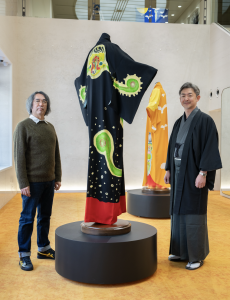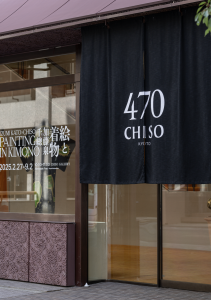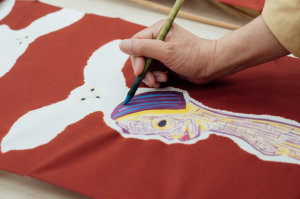Artwork collaboration: An internatinally-acclaimed contemporary artist, Izumi Kato and Chiso in Kyoto, Japan.
NAKAGYO-KU, KYOTO, JAPAN, May 16, 2025 /EINPresswire.com/ -- Founded in 1555 in Kyoto, Chiso celebrates its 470th anniversary in 2025.To mark this milestone, Chiso Gallery will host “Izumi Kato × CHISO : Painting in Kimono,” an exhibition showcasing works co-created with contemporary artist Izumi Kato.
This project began several years ago and came to fruition after extensive experimentation. Notably, the kimono-shaped works were crafted based on Katoʼs sketches, employing 20 to 30 traditional processes such as, hand-painted Yuzen, Shibori tie-dyeing, embroidery. These creations involved the collaboration of over 20 highly skilled artisans based in Kyoto.
Production took place both at Chisoʼs in-house workshop and at specialized studios throughout Kyoto Prefecture. Kato himself visited Kyoto multiple times, actively participating in the creation process. His distinctive motif known as “Hito-gata” (Human figure) was painted by himself using traditional Yuzen dyeing techniques, working side by side with the artisans. This marks a rare occurrence in Chisoʼs long history, as non-Yuzen artisans seldom contribute directly to the dyeing process on kimono fabric.
In addition to kimono works, the exhibition will feature art pieces created from fabric that, while unable to meet Chisoʼs rigorous quality standards for kimono, have been repurposed for artistic expression.
Chiso began in the Muromachi period (1336-1573) as a purveyor of religious ceremonial garments. Guided by the philosophy that “tradition is not about preservation but about creation,” the company has continually proposed new beauty and culture through its kimono. In the Meiji period (1868-1912), the company collaborated with Japanese painters, introducing innovative designs for Kyo-Yuzen. Throughout its history, these artistic encounters have consistently driven Chiso's creative endeavors to align with the times.
Through the encounter with Kato and his unparalleled sensitivity, the exhibition aims to provide an opportunity to explore new aesthetics in the future of the kimono and to create a diverse culture.
GENERAL VIEWING
Dates: Thursday, February 27th to Tuesday, September 2nd, 2025
Venue: Chiso Gallery
2F CHISO Flagship Store, 80 Mikura-cho, Karasuma Sanjo Nishi-iru, Nakagyo-ku, Kyoto, Japan
Hours: 10:00‒17:00 Closed on Wednesdays
Additional schedule changes, including summer closures, may occur.
Admission: Free
WEBSITE
https://www.chiso.co.jp/lp/izumikato/
Chiso Gallery Instagram
@chisogallery
LIMITED EDITION GOODS
Exclusive items featuring designs inspired by Izumi Kato’s drawings will be available for purchase. They are crafted from kimono fabric that narrowly missed Chiso’s stringent quality standards for production. These include “Ojami” (bean bag toys; 4 designs, sold as a set of 3), “Bandana Fukusa” (traditional wrapping cloths; available in 3 colors), and “Uchiwa” (fans; 2 designs, with a stand), which are made using traditional manufacturing techniques. All items will be available in limited quantities.
Exhibition Catalog
Scheduled for Publication at the end of June.
Organized by Chiso Co., Ltd.
Produced by Shun Takaiwa
Production supported by Izumi Kato Studio
Cooperation with PERROTIN
About IZUMI KATO
Born in Shimane Prefecture, Japan in 1969, Izumi Kato is a globally active contemporary artist
based in Tokyo and Hong Kong. Beginning his professional career around 1998, he is known for his distinctive “human-shaped” (Hito-gata) motifs, which evoke a primal and symbolic simplicity
reminiscent of childrenʼs drawings. In recent years, Kato has expanded his practice beyond painting to include sculptures made from wood, soft vinyl, fabric, stone, and cast materials. His notable solo exhibitions include: “Izumi Kato”, Red Brick Art Museum (Beijing, China, 2018), “Izumi Kato,” Fundación Casa Wabi (Puerto Escondido, Mexico, 2019), “LIKE A ROLLING SNOWBALL”, Hara Museum ARC (Tokyo/Gunma, held at two museums at the same time, 2019), “STAND BY YOU”, SCAD Museum of Art (Savannah, USA, 2021), “Parasite Model Kit”, Watari-Um, The Watari Museum of Contemporary Art (Tokyo, 2022). His public art projects include participation in: “Hawaii Triennial 2022” (Honolulu, USA, 2022), “A Summer in Le Havre” (Le Havre, France, 2022), “Sculpture Milwaukee 2024” (Milwaukee, USA, 2024), and more. Katoʼs works are part of prominent collections at institutions such as the National Museum of Modern Art, Tokyo (Tokyo), the Museum of Contemporary Art Tokyo (Tokyo), the 21st Century Museum of Contemporary Art, Kanazawa (Ishikawa), the National Museum of Art, Osaka (Osaka), the Long Museum (Shanghai, China), and the Red Brick Art Museum (Beijing, China). In 2025, Kato will have a solo exhibition at the Iwami Art Museum (Shimane) and will participate in the international art festival “Aichi Triennale 2025” (Aichi).
About CHISO
Founded as “Chikiriya” in 1555 by founder, Yozaemon Chikiriya as a purveyor of religious
ceremonial garments, Chiso has stood in Kyotoʼs Karasuma-Sanjo district for centuries. During the Edo period (1603-1868), Chiso mastered the knowledge of formal garment colors and patterns, creating ceremonial robes and altar cloths appropriate for specific families and occasions. The family also played a significant role in the townʼs governance and community leadership. In the area around Sanjo Street, Muromachi Street and Koromonotana Street, there were more than a hundred branch families derived from Chiso which displaying the goodwill of “Chikiriya” on the shop curtain hung at the front of the entrance. In the Meiji period (1868-1912), Chiso shifted the main focus of its business to Yuzen dyeing and pioneered a new expression of Kyo-Yuzen by commissioning Japanese painters to do the preliminary sketches. As a pioneer in the introduction of new designs and techniques, such as silk velvet Yuzen and Utsushi Yuzen, it became a brand appointed by the Ministry of the Imperial Household. Chiso was also actively exhibited overseas, including at the Paris World Expo. During the Taisho period (1912-1926), branch offices were established both in Japan and abroad, and trade was expanded to Europe, Southeast Asia and the Middle East. As time went on to the Showa period (1926-1989), the intensification of military policies put the dyeing and weaving industry in Kyoto in a difficult position. However, the Nishimura Textile Dyeing and Weaving Institute was established in order to preserve and pass on the techniques despite the challenges of wartime. Postwar, Chiso continued evolving, leveraging its expertise in design and dyeing for collaborations with global brands such as Montblanc, Globe-Trotter, and Suntory. In 1989, the company opened the Chiso Gallery to share its traditional art crafts, followed by the establishment of Institute for Chiso Arts and Culture, which researches and preserves Japanʼs cultural assets. The flagship Store was opened in 2020 at its original Karasuma-Sanjo location which expanded a gallery space to focus on contemporary art in 2022.
Daisuke Shiba
CHISO Co., Ltd.
d.shiba@chiso.co.jp
Legal Disclaimer:
EIN Presswire provides this news content "as is" without warranty of any kind. We do not accept any responsibility or liability for the accuracy, content, images, videos, licenses, completeness, legality, or reliability of the information contained in this article. If you have any complaints or copyright issues related to this article, kindly contact the author above.





